Jung said: “That everyone who has had practical experience of psychotherapy knows that the process which Freud called “transference” often presents a difficult problem” Transference generally becomes a factor in any long-term therapeutic relationship and it demands a full involvement and willingness to change by both the client and the therapist. Jung warns of the dangers of working with this intensity, because the doctor quite literally takes over the sufferings of his patient and shares them with him. Many forms of psychotherapy that are practiced currently do not demand this personal involvement e.g. Dialectic Behaviour Therapy with its emphasis on analysing behaviour and skills training. Hence, modern training methods do not always adequately prepare the practitioner for dealing with the difficulties that can arise in the therapeutic relationship.
Psychotherapy is a method for treating psychic or somatic disorders with psychological means such as hypnosis, suggestion, psychological re-education, persuasion etc. and the use of the therapist patient relationship.
A tradition of mental healing based on the influence of one psyche on another (the transference / countertransference model) evolved from shamanism, to exorcism, to the theory of animal magnetism (Anton Mesmer), to the use of hypnosis in the early 19th century.
Freud moved from hypnosis and the cathartic method to working with free associations of his patients. He developed the talking cure (verbalisation of the repressed), which he called psychoanalysis. This method of investigation is based on bringing out the unconscious meaning of words, action and products of the imagination (dreams, phantasies and delusions) of the analysand. Freud developed the theory of transference, where relationship patterns developed in childhood become templates for future relationships. This mode of relating is then transferred to others in adult relationships. He postulated that an unconscious idea can only become conscious by attaching itself and transferring its emotional intensity to an already conscious idea. He originally saw it only as the affect being displaced from one idea to another. He then recognised that transference is an essential part of the therapeutic relationship and introduced the concept of a transference neurosis: Freud wrote: ‘….we regularly succeed in giving all symptoms of the illness a new transference meaning and in replacing the patient’s ordinary neurosis by a “transference-neurosis” of which he can be cured by the therapeutic work’.
Douglas A. Davis, Professor of Psychology at Harvard College in Pennsylvania, somewhat cynically describes this process as: “In the therapy Freudian would practice, seduction became the metaphor for the patient-doctor transference. The patient falls for an analyst, whose every move will be assimilated to the erotic and aggressive metaphors of the transference. Understanding the transference is then the key to recovery from the neurosis.”
Jung became interested in Freud’s work and asked himself whether the psychoanalytic method could be used with his psychotic patients in Burghölzli, where he worked as an Assistant Staff Physician to Eugen Bleuler. Jung realised the enormous importance that Freud attached to the transference phenomenon. When Freud asked Jung at their first personal meeting in 1907: “And what do you think of the transference?” Jung said he replied with the deepest conviction: “It is the alpha and the omega of the analytical method.” Freud then replied: “Then you have grasped the main thing.”
Jung tried to find a model that pictured how two people start to experience transference, when the relationship is about doing psychological work together. He noticed particular patterns and chose the alchemical process to help him makes sense of these patterns.
Jung used a series of ten woodcuts from the alchemical text Rosarium Philosophorum published in Frankfurt in 1550 as a guiding metaphor and visual amplification for the transference and the individuation process. Jung believed that wholeness is the aim of psychological work (individuation), which involves the withdrawal of projections and the assimilations of the unconscious content into the conscious being.
We can only become aware of the unconscious through projection. Hence, we need to be in relationship and dialogue with other people and our inner figures such as the shadow or the anima / animus to participate in the individuation process.
The first step in the analytic process is the establishment of the container in which analysis takes place and the ground rules for analysis. This includes everything from the physical setting i.e. the room in which the analysis is conducted to how people will interact with each and the boundaries of the relationship between client and therapist. Various practical issues will need to be discussed like the frequency and length of sessions, payment, confidentiality, what to do about missed sessions and holidays and the reason why the clients wants to undergo an analysis.
The Mercurial Fountain

We are the beginning and first nature of metals,
Art by us maketh the chief tincture.
There is no fountain nor water found like unto me.
I heal and help both the rich and the poor,
But yet I am full of hurtful poison.
First of all there needs to be a meeting place where transformation (transformative events, transformative waters) can take place. Jung used the metaphor of a fountain. He said, “This picture goes to the heart of the alchemical symbolism, for it is an attempt to depict the mysterious basis of the opus.” The basin of the fountain provides containment and it can become a vessel of gestation. The water (mare nostrum, aqua permanens, divine water) is a source of life. There is also the idea of things bubbling up from below (the unconscious). There is a sense of mysteriousness surrounding this image. Christopher Perry interprets the fountain being fed from above and below as depicting the conscious and the unconscious relationship of the analyst and the patient. This is at the beginning of the analysis, where the two people do not know each other and may think of each other as virginal, dangerous, and life giving. They are embarking on a journey and are inviting Mercurius to transform them. Mercurius is a tricky archetype with a fondness for sly jokes, malicious pranks, a dual nature (half animal / half divine) and a power to change shape. He brings the possibility of transforming the meaningless into the meaningful. Hence analysts and clients need to take note of the warning that is in the inscription that goes with the fountain, which promises health or sickness and mental well being and poison.
In my own analytic journey, I have an image of an old well in a clearing of a European forest. The well is made of stone and is very deep and dark. It has water in it and goes to the beginning of time. The well is attended by Rohanna with the red hair, the long green dress, and the strong boots.
I have the experience and image of a box, a sarcophagus (meaning a stone that eats people) in my psychic being, because I have been forced as a child to spend time in a closed and cold coffin. My alchemical problem is that if I enter a room or a setting that reminds me of the coffin, of being closed in or locked up, I get frightened and I want to run away (leave physically or dissociate mentally). I know I have to approach this scene with the coffin carefully before I can be transformed. Therefore, I need to have the fountain established first as a safe place, where the grace of God can work through the life giving water. I can then experience the care of the tender loving and compassionate fluids.
In my picture of the well, I have Rohanna, the red, I am protected by the four archangels, and Mary, who is dressed in blue and white, comes to visit from time to time. It is a place, where I can communicate with faeries and hence dialogue with the images and personalities of my unconscious.
King and Queen
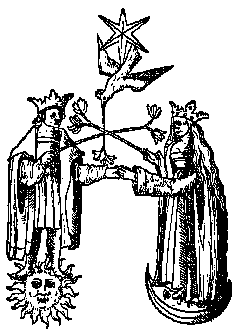
In this picture the King and Queen, brother and sister, standing on Sol and Luna approach each other for the purpose of betrothal. It is a distant meeting suggested by the court clothes. They touch with the left hand, which suggests a sinister, emotional connection, the unconscious, and a beginning of projective and introjective identification. There is a counter-crossing of the sexes. The man (adept) is projecting his anima and is represented by the queen and the woman (soror mystica) is projecting her animus and is represented by the King. The union of the right hands is mediated by the Holy Spirit. This scene can apply to same sex analytical couples or the internal work of one person. The symbolism of the male and female, King and Queen, Sol and Moon is important, because it implies that we need to integrate different aspects and qualities of ourselves. Jung said that the first work is dialoguing with and integrating the shadow and only then can we approach a dialogue with our animus or anima. One area that has been written about a lot is the erotic transference. It is usual that the client will fall in love with the therapist and it can have serious complications, if the analytic couple acts on these feelings and has a sexual relationship rather working with the meaning of the transference communication. The sexual feelings in an erotic transference need to be felt, understood, and worked with until the unconscious meaning becomes clear to both parties.
Jung separated transference into personal and archetypal components. Personal transference includes the aspects from the client’s past relationship e.g. relationships to his parents, which he projects onto the analyst. It also includes his shadow and his potential. Archetypal transference is not based on the client’s outer world experiences, but on his unconscious fantasies e.g. he might see the analyst as a magical healer or terrifying devil. Archetypal transference also includes a generally predictable form of relationships between the client and the therapist, which Samuels and San Roque have adapted from Jung.
JUNG'S QUADRANT OF TRANSFERENCE DYNAMICS
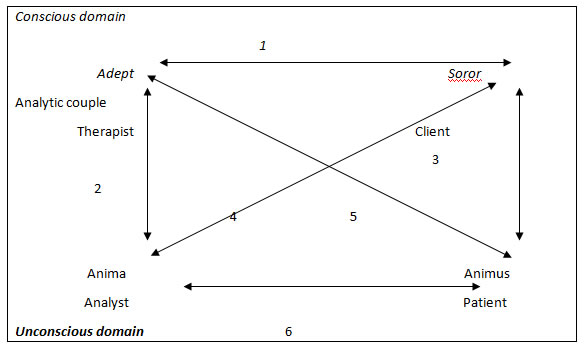
The double-headed arrows indicate a two-way communication and relatedness.
1. Conscious working alliance between therapist and client or an uncomplicated personal relationship
- 2. Therapist’s communication with his unconscious, which he uses to understand the client and also connects to the material that makes him a wounded healer. Or a relationship a man has to his anima.
- 3. Client’s' relationship with her pre or unconscious representing her initial awareness of her problems, which is interrupted by resistance and her devotion to her persona. Or a relationship a woman has to her animus.
- 4. and 5. Indicate the impact of the therapeutic relationship upon the unconscious life of each participant, as an intermingling of personalities, which will lead each to some kind of confrontation with the possibility of personal change.
- 6. Proposes a direct communication taking place subliminally in the dimensions of ‘the unconscious’ psyche/soma.
The Naked Truth
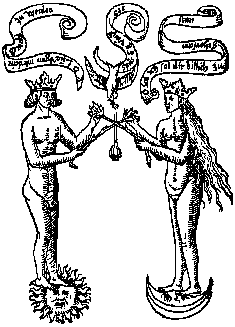
The text that goes with this picture admonishes the adept to behave in a moral manner and to fear God. Hence, this opus is a moral and a psychological undertaking. This picture is a challenge to both parties to become completely honest, give up their personas and to continue with the process of mutual transformation, which is watched over by the dove, the Holy Spirit, which unifies. Jung said that the bond established by the transference is not only important to the individual, but also for the society and for the moral and spiritual progress of people everywhere.
This process can mean that people literally take their cloths off as they work with each other like in Tantric sex or it can be taken metaphorically as people becoming more naked to each other. Generally, clients are a bit shy at the beginning and are more willing to expose their secrets and shameful feelings as the trust in the relationship and the therapist grows. The shadow is now raised to consciousness and integrated with the ego. This can never be fully complete, because the shadow is an archetype, but we can learn to live with our shadow without causing a series of disasters. The whole process requires the dove, a form of grace, a spark of life needs to be present, so that people are willing to become more trusting and reveal themselves to each other.
Immersion in the Bath
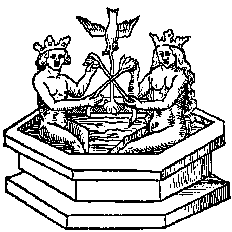
The couple is descending into the water (unconscious). They are united above by the Holy Spirit and below the water, which is the counterpart of spirit. Heraclitus said “It is death for souls to become water”. It means the conscious union of the ego with everything that has been projected into the other. It also represents our longing to fuse with another, a form of projective identification.
This process can apply to a couple in an analytic setting, but one could also put elements of one’s psyche into the water e.g. little Dorothea with Rohanna. During the immersion process the couple could become aware of the things that frighten them e.g. little Dorothea might become frightened of the monsters in the water.
The Conjunction (Coniunctio)
The Conjunction (Coniunctio) |
Fermentatio |
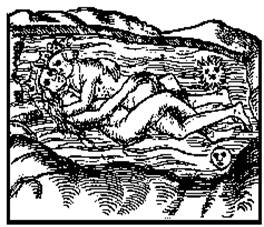
|
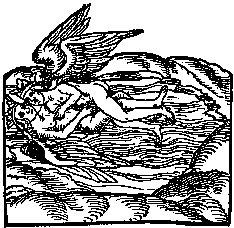
|
O Luna, by means of my embracing and sweet kisses,
Thou art made beautiful, strong and mighty like as I am.
O Sol, thou art to be preferred before all light,
But yet thou needest me, as the cock does the hen. |
Here Sol is again included,
And is circumpassed with the Mercury of Philosophers. |
The sea has closed over the King and Queen and they have gone back to the chaotic beginnings, the massa confusa. Physis has wrapped the man of light in passionate embrace. The real meaning of the coniunctio is that it brings birth to something that is united and one. The birth of a son restores the vanished “man of light” who is identical with the Logos in the Christian and Gnostic symbolism.
Jung said “For at this juncture the meaning of the symbol is fulfilled: the partners have themselves become symbolic. At first each represented two elements; then each of them united into one (integration of the shadow); and finally the two with a third become a whole. Thus the axiom of Maria is fulfilled.” The Holy Spirit disappears and Sol and Luna become spirit.
A union of unlike substances has occurred, which results in the birth of a child that has the potential for greater wholeness by combining the attributes of both the opposing natures. Death, loss, and rebirth are possibilities. An unconscious part of the personality has been redeemed. At this point in the therapeutic relationship, the couple may be deeply in love as well as in hate.
The couple is experiencing a more intimate relationship, a blending of their psyche like, a joining. Two men for example might feel that they are getting closer together and experience a son and father relationship or feel like two brothers or experience a more sensual relationship or if they are homosexual, they might experience a sexual relationship. Women might experience sisterly relations or lesbian feelings. A whole range of feelings other than love, hate and sexual feelings could be experienced, because of this combining of the elements. These feelings of bonding and / or merging and the fear of these feelings can also be experienced outside the analytic setting,
Death
Conception or Putrefaction
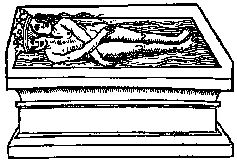
Here lie the King and Queen dead.
The Soul is separated with great grief
The vas hermeticum, fountain and sea have become a sarcophagus and tomb. The King and Queen are dead and have melted into a being with two heads. This is a dark time of despair and disillusionment. This can be thought of as the stage, when a seed has been planted and it has to be underground and be dormant before it can germinate and reach new life. This may be the end of the honeymoon period in therapy or in a relationship. Both client and therapist need faith in the relationship and in the process to counteract the despair. This stage is called nigredo, the blackening.
We have to die to part of ourselves in order to encounter the thing we do not wish to be (the shadow), and the thing we are not (the individual reality of the other), and the psychic non-ego (the collective unconscious). Jung says that the aim of the opus psychologicum is conscious realisation. First, one has to become conscious of what one projects onto the other. By gradually recognising and taking back our projections we will get to know ourselves and the people we relate to. Then I will find out who I am and learn to recognise what is projected onto me and what I imagine myself to be.
In my own process, my little doll self has gone down the well and she might need to stay there for some time. Rohanna cannot just go down and rescue her. My little doll self might need to be frightened and lost and experience despair. This has to be seen and felt before something else can happen. At this stage, Rohanna and Dorothea have almost become one body with two heads, because they are part of same thing. At the moment Rohanna and Dorothea have to spend time together, being quiet together, maybe sleeping together, or being under the ground together like a seed in winter. And during that time, it seems like the soul leaves.
The soul leaving could be interpreted as a period of separation, a period of depression, or a loss of soul. The soul can leave you literally by getting really sick and dying. And I know in my own case I felt my soul leaving, when my mother died. I had to like Winnebago (an American Indian trickster spirit) put my heart aside for a year and a day, so that I could function, organise the funeral, and inform all the relatives. I even gave an oral presentation to a group colleagues on the day she died, just after I had arranged to meet with a funeral director.
The Ascent of the Soul
The Extraction or Impregnation of the Soul
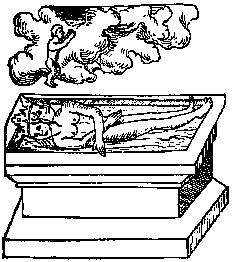
Here the Four Elements are separated,
And the Soul is most subtly severed from the Body.
This image presents a paradox, where the ascent of the soul is juxtaposed with being impregnated. Only one soul departs from the body, because the two have become one. This is a dark state of disorientation. The decomposition of the elements indicates dissociation and the collapse of the existing ego-consciousness. Jung said the therapist must hold onto his own orientation. The therapy is aimed at strengthening the conscious mind. St John of the Cross, a medieval mystic, wrote about the dark night of the Soul and said that the invisible and dark radiance of God can pierce and purify the soul during these experiences. Thomas Moore has recently published a book “Dark nights of the Soul. A guide to finding your way through life’s ordeals” to assist readers in our modern age to find solace and nurturing through these experiences.
States of fusion, merger, or projective identification lead to a loss of soul and a loss of the I-Thou, Ego-Self, conscious-unconscious relatedness. This may lead to disintegration, dissociation, splitting or it could be a step along the path of individuation. This is a difficult and dangerous time in therapy and needs to be handled very carefully.
Purification
Washing or Mundification
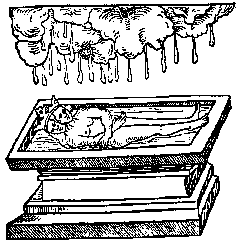
Here the dew falleth from heaven,
And washeth the black body in the sepulchre.
The falling of the dew is the portent that the divine birth is now at hand. The whitening (albedo) is likened to the sunrise; it is the light, the illumination that follows the darkness. The nigredo of despair and loss of soul are followed by the falling of the heavenly dew. The purification of the body is like preparing the soil of the analytic relationship for the return of the transformed soul.
I can think of two significant moments that have prepared my body for the return of my soul. One was a psychodrama in which I decided to live instead of dying. And Rohanna has called on her friend Ignatius, an Austrian mountain climber, to help her prepare for the return of my little doll self from the well. Ignatius is climbing down the well and constructing footholds with pit irons so that my little doll self can use them to climb up. This is a slow process and will take time and will happen pit irons by pit iron.
The Return of the Soul
Of the Rejoicing or Springing or Sublimation of the Soul.
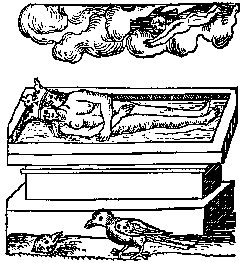
Here the Soul descendeth from on high,
And revives the putrefied body.
The soul dives from heaven and revives the body. This is a stage of joy. The process is transcendental and there is the danger of inflation, because the coniunctio is a hierogamos of the gods and not a mere love-affair between mortals. It is important to deal with the after-effects of the fusion of opposites, which have involved the conscious personalities in their union. One extreme consequence could be the dissolution of the ego in the unconscious, a state resembling death. This results from a more or less complete identification of the ego with unconscious factors. This contamination needs to be cleansed during the purification phase, so that the person can distinguish between him or herself and the collective unconscious. This process of psychological differentiation is difficult and needs tenacity and patience.
This is why the return of my little doll self will be a slow and laborious process. She will have to go through death and the sarcophagus on her way up the well, before she can rejoin me again in my body.
The New Birth
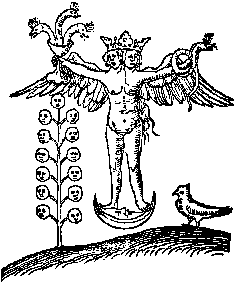
Here is born a noble and rich Queen
Whom the wisemen liken unto their daughter
She increaseth and bringeth forth infinite children
Which is immortal pure and without spot
The Queen hates death and poverty
She excels both Silver and Gold and precious stones
And all medicines both precious and base
There is nothing in this world like unto her
For which we render thanks to Immortal God
The hermaphrodite is born out of the mystical union and looks towards the left and right (the unconscious and conscious). At the end of the process, both client and therapist will have travelled further along the path of individuation and they will both have been transformed by the work. The client now can call on the experiences of the analysis and will have hopefully a fishing rod so he can catch his own fish. I mean he or she may have internalised enough of the therapist and the therapeutic process so that this can be helpful in difficult future times. The therapist will have learned from his or her mistakes, gained more clinical experience and from the deep and personal contact with another person. As Jung said the opus is a process of individuation, a becoming of the self. And the transference process provides a rich vessel for the transformation of the analytic couple.
Jung, C.G. (1954) ‘The Psychology of the Transference.’ In the Practice of Psychotherapy. Collected Works, Vol 16, Bollingen Foundation p 172 para 358
Jung, C.G. (1954) CW Vol 16, p 164 Foreword
LaPlanche, J. & Pontalis J. B. (1973). The language of Psychoanalysis. W W Norton & Company. New York p 373
Douglas Claire (1997). ‘The historical context of analytical psychology.’ In Polly Young-Eisendrath & Terence Dawson The Cambridge Companion to Jung. Cambridge University Press p 25
LaPlanche, J. & Pontalis J. B. (1973). The language of Psychoanalysis. W W Norton & Company. New York p 367
Freud. S (1914) ‘Remembering, Repeating and Working through.’ In LaPlanche, J. & Pontalis J. B. (1973). The language of Psychoanalysis. W W Norton & Company. New York p 458
Davis, Douglas A. (1997). ‘Freud, Jung and Psychoanalysis.’ In Polly Young-Eisendrath & Terence Dawson The Cambridge Companion to Jung. Cambridge Univesity Press p 37
Jung, C.G. (1954) CW Vol 16, p 171 para 358
De Alchimia opuscula complura veterum philosophorum. Frankfurt 1550 retrieved 14 June 2005 from Http://www.levity.com/alchemy/rosarium.html
Jung, C.G. (1954) CW Vol 16, p 203 para 402
Perry, Christopher (1997). Transference and Countertransference. In Polly Young-Eisendrath & Terence Dawson The Cambridge Companion to Jung. Cambridge Univesity Press p 148
Samuels, A., Shorter B. and Plaut, F (1986) A critical dictionary of Jungian Analysis, Brunner-Routledge, New York p 152
based on the German words “Ich mach gesund arm und reych. Und bin doch gsund gystig und dötlich.” Figure 1 in Jung, C.G. (1954) ‘CW, Vol 16, p 205
Samuels, A., Shorter B. and Plaut, F (1986) A critical dictionary of Jungian Analysis, Brunner-Routledge, New York p 20
Based on Jung, C.G. (1954) CW Vol 16, p 221 para 422 and Samuels, A., Shorter B. and Plaut, F (1986) A critical dictionary of Jungian Analysis, Brunner-Routledge, New York p 20 and San Roque (2005) Section Two. On Cultural Transference.
Jung, C.G. (1954) ‘CW, Vol 16, p 234 para 449
Jung, C.G. (1954) ‘CW, Vol 16, p 246 para 455
Jung, C.G. (1954) CW Vol 16, p 247 -248 para 458 - 459
Jung, C.G. (1954) CW Vol 16, p 252 para 462
Samuels, A., Shorter B. and Plaut, F (1986) A critical dictionary of Jungian Analysis, Brunner-Routledge, New York p 25
Perry, Christopher (1997). Transference and Countertransference. In Polly Young-Eisendrath & Terence Dawson The Cambridge Companion to Jung. Cambridge Univesity Press p 152
Jung, C.G. (1954) CW Vol 16, p 257 para 467
Jung, C.G. (1954) CW Vol 16, p 262 para 470
Jung, C.G. (1954) CW Vol 16, p 262 para 471
Moore, Thomas (2004) Dark nights of the Soul. A guide to finding your way through life’s ordeals. Piatkus Books Ltd. London
Perry, Christopher (1997). Transference and Countertransference. In Polly Young-Eisendrath & Terence Dawson The Cambridge Companion to Jung. Cambridge Univesity Press p 153
o0o

